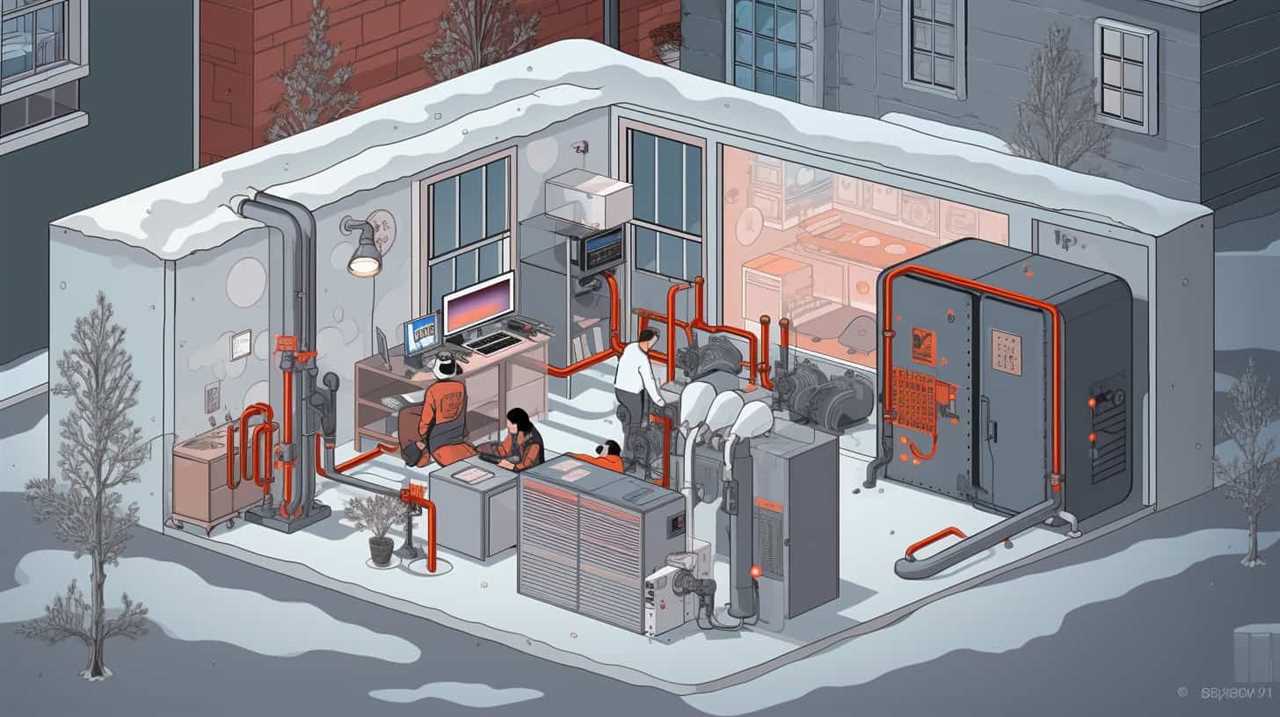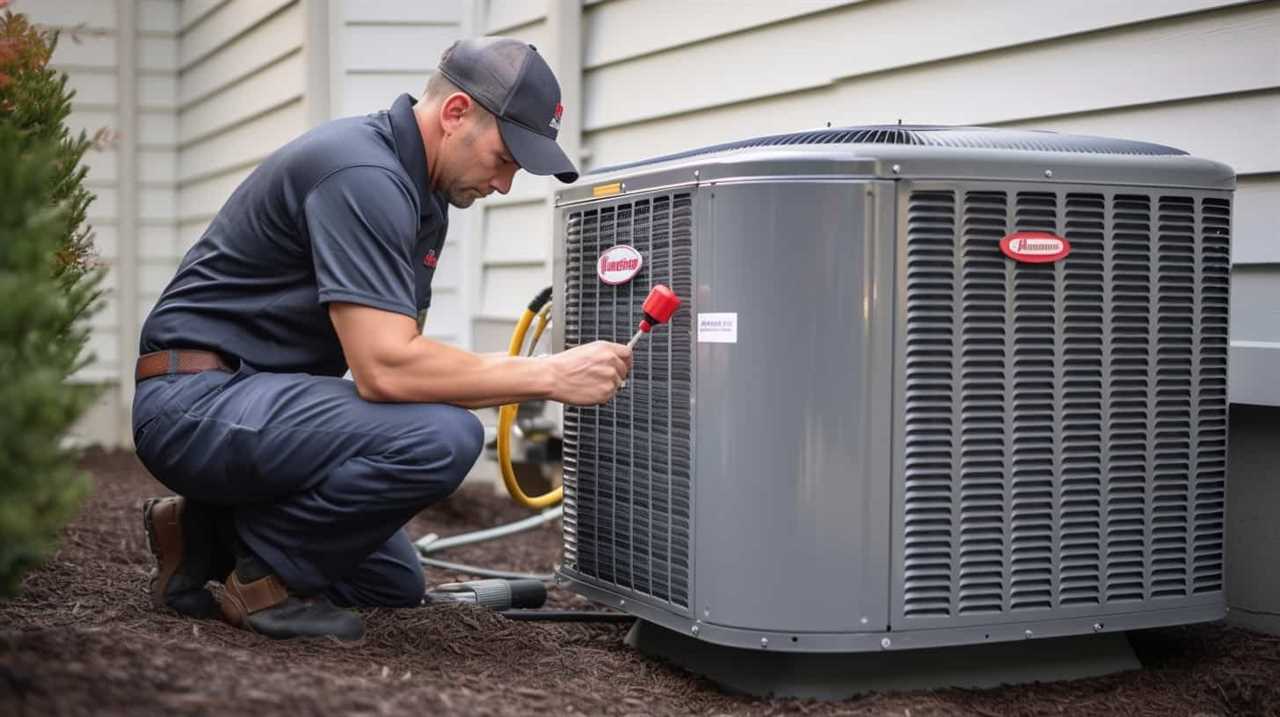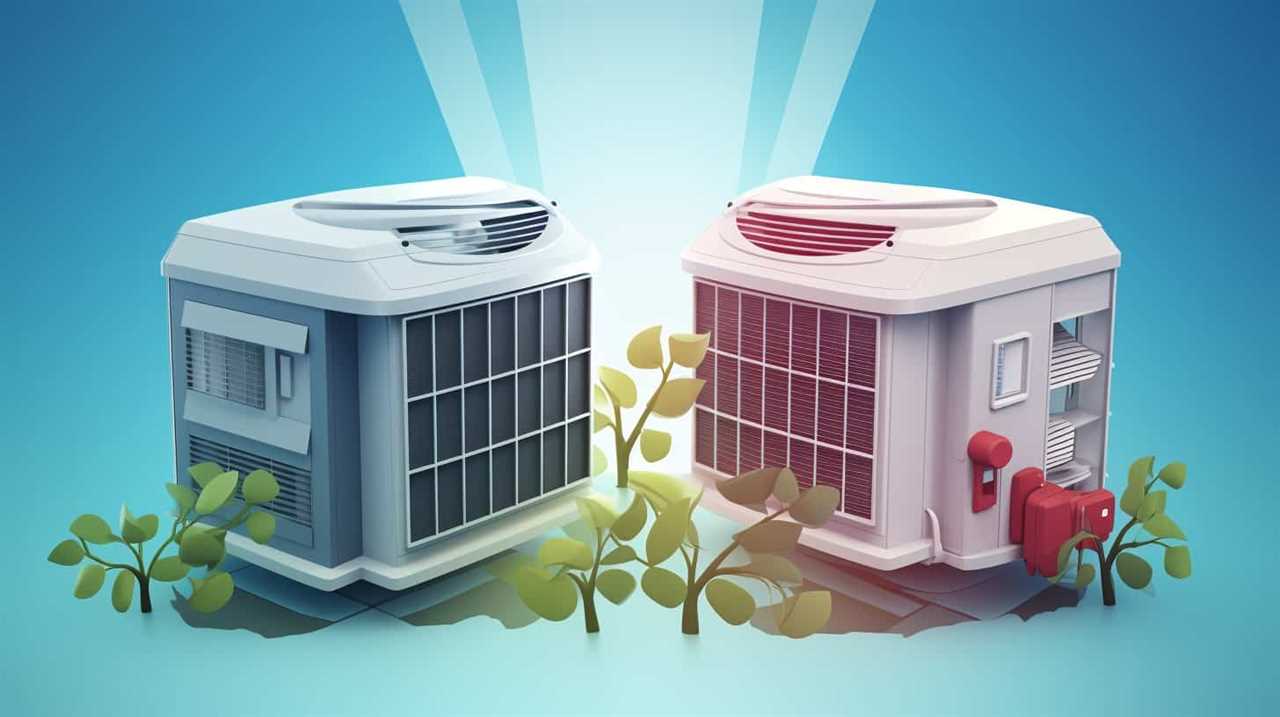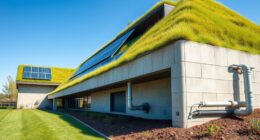Do you ever think about how to increase the efficiency of your heat pump? If so, you’re in luck! In this article, we will share some important strategies to enhance the efficiency of heat pumps in sustainable buildings.
From proper sizing to enhancing insulation and sealing, optimizing airflow and ventilation, and even upgrading to high-efficiency systems, we’ve got you covered.
Plus, we’ll show you how implementing smart thermostat controls can take your heat pump efficiency to the next level.
Get ready to master the art of maximizing your heat pump’s performance!

Key Takeaways
- Proper heat pump sizing and installation are essential for optimizing energy efficiency and system performance.
- Insulation, sealing, and regular maintenance contribute to a sustainable and efficient heat pump system.
- Properly designed ductwork, air filtration, and ventilation control enhance heat pump efficiency and performance.
- Upgrading to high-efficiency heat pump systems with advanced features and smart thermostat controls can significantly reduce energy consumption and carbon emissions.
The Importance of Proper Heat Pump Sizing
Why is proper heat pump sizing important for sustainable buildings?
Proper heat pump sizing is crucial for optimizing energy efficiency and ensuring the long-term performance of the system. An undersized heat pump will struggle to meet the heating or cooling demands of the building, resulting in decreased comfort and increased energy consumption.
On the other hand, an oversized heat pump will cycle on and off frequently, leading to inefficient operation and unnecessary wear and tear on the equipment. To achieve proper heat pump sizing, it’s essential to consider factors such as the building’s size, insulation levels, climate, and specific heating and cooling needs.
Additionally, proper heat pump installation and regular maintenance are crucial to maximize efficiency and extend the lifespan of the system. Following heat pump maintenance tips such as cleaning air filters, checking refrigerant levels, and inspecting ductwork can help optimize performance and reduce energy consumption.

Enhancing Heat Pump Insulation and Sealing
To improve heat pump efficiency, we can enhance insulation and sealing. Proper insulation and sealing help reduce heat loss and prevent air leaks, leading to improved performance and energy savings. By minimizing heat transfer between the heat pump and its surroundings, we can optimize its operation and reduce the workload on the system. This not only improves energy efficiency but also extends the lifespan of the heat pump. In addition to insulation, regular heat pump maintenance is essential for optimal performance. This includes cleaning or replacing filters, checking refrigerant levels, and lubricating moving parts. Furthermore, addressing noise issues associated with heat pumps can also enhance their overall efficiency. Insulation and sealing, along with other maintenance measures, contribute to a more sustainable and efficient heat pump system.
| Benefits of Enhancing Insulation and Sealing |
|---|
| Reduces heat loss |
| Prevents air leaks |
| Improves energy efficiency |
| Extends heat pump lifespan |
Transitioning into the subsequent section about optimizing heat pump airflow and ventilation, it is important to consider how these factors interact to maximize efficiency and performance.
Optimizing Heat Pump Airflow and Ventilation
By ensuring proper airflow and ventilation, we can optimize the efficiency and performance of our heat pump system. To achieve this, we need to implement effective airflow optimization and ventilation strategies. Here are three key approaches to consider:
Ductwork design: Properly designed and sized ductwork can minimize airflow restrictions and pressure drops, allowing the heat pump to operate more efficiently. This includes optimizing duct lengths, minimizing bends, and ensuring proper sealing.

Air filtration: Clean air is essential for the heat pump’s performance and longevity. High-quality air filters should be installed to remove dust, debris, and pollutants from the air, preventing them from clogging the system and reducing its efficiency.
Ventilation control: Implementing ventilation strategies such as heat recovery ventilation (HRV) or energy recovery ventilation (ERV) can help maintain indoor air quality while minimizing energy loss. These systems exchange heat and moisture between incoming and outgoing air streams, reducing the load on the heat pump.
Upgrading to High-Efficiency Heat Pump Systems
Our goal is to maximize the efficiency and sustainability of our heat pump system by upgrading to high-efficiency heat pump systems.
Upgrading to high-efficiency heat pump systems offers several advantages. Firstly, these systems are designed to operate with higher energy efficiency ratings, resulting in lower energy consumption and reduced carbon emissions.

Secondly, high-efficiency heat pump systems often incorporate advanced features such as variable-speed compressors and smart thermostats, which further optimize performance and energy usage.
Additionally, upgrading to high-efficiency heat pump systems can also lead to cost savings through reduced energy bills and potentially qualify for heat pump rebates offered by government and utility programs.
It’s important to note that proper heat pump maintenance is crucial to ensure optimal performance and longevity of these systems. Regular maintenance, including cleaning filters, checking refrigerant levels, and inspecting ductwork, can help identify and address any issues promptly, maximizing the efficiency and lifespan of the high-efficiency heat pump system.
Implementing Smart Thermostat Controls for Heat Pumps
Installing smart thermostat controls for our heat pumps can significantly improve energy efficiency and optimize our heating and cooling settings. With advanced features and remote temperature monitoring, these smart thermostats provide an array of benefits for sustainable buildings.

Here are three key reasons why implementing smart thermostat controls is crucial for maximizing heat pump efficiency:
Energy saving features: Smart thermostats offer energy-saving features such as programmable schedules and learning algorithms that adapt to our preferences and occupancy patterns. By automatically adjusting the temperature based on our needs, these features minimize energy waste and reduce our carbon footprint.
Remote temperature monitoring: With smart thermostats, we can monitor and control our heat pump settings remotely through smartphone apps or web interfaces. This enables us to make real-time adjustments, ensuring optimal comfort and energy efficiency even when we’re away from home.
Enhanced analytics and insights: Smart thermostats provide detailed energy usage data and analytics, allowing us to identify energy-saving opportunities and make informed decisions. By understanding our energy consumption patterns, we can fine-tune our heating and cooling settings to achieve maximum efficiency.

Frequently Asked Questions
Are There Any Government Incentives or Tax Credits Available for Upgrading to High-Efficiency Heat Pump Systems?
There are government incentives and tax credits available for upgrading to high-efficiency heat pump systems. These incentives and credits can help offset the initial costs and promote the adoption of sustainable building practices.
How Can I Determine the Proper Size of a Heat Pump for My Building?
To determine the proper size of a heat pump for our building, we should consider factors like the square footage, insulation, and climate. This analysis will ensure maximum efficiency and optimal performance.
What Are Some Common Signs That Indicate My Heat Pump’s Insulation and Sealing Is Inadequate?
Common signs of heat pump insulation issues include uneven heating or cooling, high energy bills, and excessive noise. To improve heat pump sealing, check for air leaks, insulate ductwork, and seal gaps around windows and doors.
Can I Install a Smart Thermostat for My Heat Pump Without Professional Assistance?
We can install a smart thermostat for our heat pump without professional assistance. It’s a DIY project that can enhance our system’s efficiency and control. Follow the manufacturer’s instructions for proper installation and configuration.

Are There Any Maintenance Tasks or Regular Check-Ups Required to Ensure Optimal Airflow and Ventilation for My Heat Pump System?
To ensure optimal airflow and ventilation for our heat pump system, we must perform regular maintenance tasks. This includes cleaning or replacing air filters, checking for obstructions in ducts, and inspecting the outdoor unit for debris buildup.
How Can Energy-Efficient Heat Pumps Contribute to Sustainable Buildings?
Energy-efficient heat pumps play a crucial role in enhancing home sustainability with heat pumps. By harnessing renewable energy, these systems transfer hot or cool air throughout a building, helping to regulate indoor temperatures while minimizing energy consumption. This not only reduces greenhouse gas emissions but also lowers energy bills, making sustainable buildings more affordable and environmentally friendly. With their ability to provide efficient heating and cooling, heat pumps are becoming a key component in achieving sustainable and eco-friendly homes.
Conclusion
In conclusion, by implementing these strategies, we can dramatically enhance the efficiency of heat pumps, leading to more sustainable and environmentally-friendly buildings.
The improvements in sizing, insulation, airflow, and system upgrades, combined with the use of smart thermostat controls, will ensure optimal performance and energy savings.
With these measures in place, we can achieve outstanding heat pump efficiency, taking us one step closer to a greener and more sustainable future.










